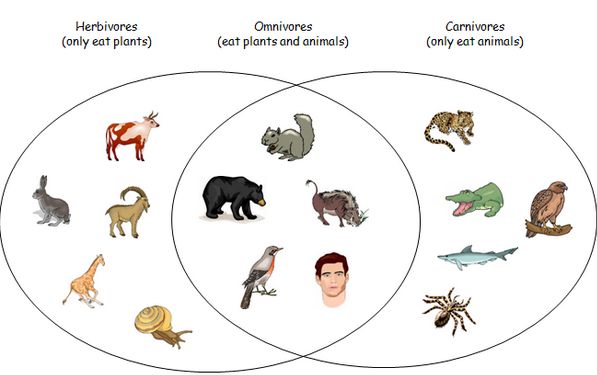- Books Name
- Class 6 Science Book
- Publication
- PathSet Publications
- Course
- CBSE Class 6
- Subject
- Science
What do Animals Eat?

Animals can be classified into three broad categories in terms of what they eat as can be seen in the image above,
Different Type of Animals
Herbivores
Animals which eat only plants and plant products are called herbivores. For example: Elephant, rabbit, horse, Cow etc.
Carnivores
Animals which eat other animals are called carnivores. For example: Lizard, Lion, tiger, crocodile etc.
Omnivores
These animals eat both plants and animals. For example: Dog, cat, crow, etc.
First we have the Herbivores i.e. plant eaters. They only consume plant parts. Examples: Cows, goats, deer, giraffe etc.
Next we have the Carnivores i.e. meat eaters. They only consume meat of other animals. Examples: Lions, tigers, vultures etc.
Last we have Omnivores i.e. animals who eat both plant parts and meat products. Examples: Humans, bears etc.
- Animals are unable to produce their own food by the process of photosynthesis, they only consume food made by others, and hence called CONSUMERS.
- Animals are grouped into 3 categories based on their food habits.
- Herbivores - Herbivores Animals are those animals that feed on plants i.e, these are animals that eat only plants or plant products.
- Carnivores - Carnivorous animals are those animals who eat other animals. So, carnivores Animals that feed on other animals are called carnivores.
- Omnivores - animals that eat both plants and animals.
- Table given below shows examples of different types of animals

Special characteristics of Herbivores
- Herbivores like a cow, horse, and goat have wide, blunt teeth which are suitable for pulling plants off the ground and grinding them.
- Herbivores like cow and camel have the ability to bring back previously swallowed food to the mouth for chewing it the second time. This helps them to absorb most of the nutrients from hard-to-digest food like grass.
- Squirrels have a pair of broad, sharp-edged front teeth (incisors) in each jaw They use these teeth to gnaw food items like nuts.
- Butterfly and hummingbird do not need to worry about chewing their food. They have mouth parts shaped like a straw to suck nectar from flowers.
Special Characteristics of Carnivores
- The diet of carnivores is rich in fats and proteins
- Carnivores animals like lion and tiger have sharp and pointed front teeth (canines). They also have sharp claws and powerful jaws which help them to tear flesh.
- Carnivorous birds like eagle have curved, pointed beaks that allow them to tear flesh.
- Carnivores like chameleon and frog have a long, sticky tongue that they use to catch insects.
- Carnivorous fish like a shark has several small, sharp teeth that help them bite off chunks of flesh.
- Carnivores such as snakes swallow their prey (prey are animal that is hunted or killed for food) whole.
Special Characteristics of Omnivores
- Omnivores like a bear and human beings have different types of teeth that help them to eat both plants and the flesh of other animals.
- Omnivorous birds like crow have a sharp and pointed beak to help them eat a
variety of food.
Scavengers and Decomposers:
- Scavengers are birds and animals which eat the flesh of other dead animals. Eg: Vulture.
- Decomposers are organisms that feed on and destroy (or decompose) dead plants and animals. E.g.: Fungi and bacteria
- Both scavengers and decomposers play a very important role in cleaning the environment. Without them, our planet would be covered with dead plants and animals.
There are five major components of food namely vitamins, minerals, proteins, carbohydrates and fats. While the diet of carnivores is rich in fats and proteins, there are some necessary vitamins and minerals in plant-based foods that their diet lacks. Similarly, an all plant-based diet lacks in a good amount of protein and certain minerals.
It is important to know that there is difference between vegetarians and herbivores. While vegetarians make a conscious decision to not eat meat, herbivores on the other hand are incapable of eating meat and dairy products. Similarly, carnivores lack the necessary enzymes in their stomachs to digest cellulose which is a major component of green food like grass.

 Param Publication
Param Publication
 PathSet Publications
PathSet Publications
